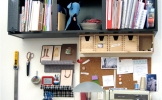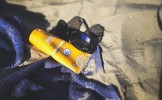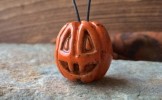Posted by Darlene Ostrowski
In October, even the most mainstream stores are filled with skulls, spiders, and vampires of all varieties, from sexy to scary. But for Chicago's gothic and dark alternative crafters, every day is Halloween.
These local artists create things that go bump in the night all year 'round, and spoke to IndieMade about creating art inspired by the darker side of life.
Natasha Mark
Chicago artist and crafter Natasha Mark grew up watching "The Addams Family," "The Munsters" and horror movies, and that spooky aesthetic has stayed with her to this day.
"I think my parents thought that it was just a phase and that their little 'Morticia' would grow out of it," says Mark, of NatashaBlue, who creates Day of the Dead-inspired skull art, crafts, and jewelry. "Twenty years later, I think they’ve given up. It’s who I am -- black clothes, tattoos, skeleton paintings and all."
Mark first picked up a paintbrush four years ago as a creative outlet to relieve stress from a demanding job. Intending to paint pieces to hang in her house, she found herself inspired by the hauntingly beautiful images of the Latino holiday that honors lost loved ones.
"At the time, it was hard to find Dia de los Muertos-inspired art in Chicago," Mark says. "I created images that I wished I could find."
Her friends encouraged her to put her work up for sale, and while "I honestly had no clue what I was doing at the time and was extremely nervous about the thought of putting my work out for the public to see and perhaps criticize," she was well-received online. Within months, she landed a solo exhibit at a local gallery, and she began vending at neighborhood art festivals that summer.
Mark, who often sells her skulls at comic and horror conventions as well as more traditional craft fairs, acknowledges that not everyone understands a dark artist's aesthetic.
"I usually have very positive responses to my work. However, I do have people tell me my work is ugly or scary or give me incredibly horrified looks," she says. "I’ve received hate mail from complete strangers who think I’m Satanic."
But, she says, for every negative person she encounters, there are many more who get genuinely excited about her creations. "When I started selling my art, one of my customers said, 'I know it sounds weird because it’s a painting of skeletons, but it’s so beautiful how you capture so much emotion in their expressions.' For a self-taught artist that was quite the compliment," Mark says.
Eliza Stockfisch
"I love when someone comes up to [my work] because they like it from afar," says artist and crafter Eliza Stockfisch, of Schiller Park, IL. "Then they notice something that's weird, screwed up or gross about the painting. It kind of throws them off, like, 'I like this but I shouldn't.' It always makes me smile."
A freelance illustrator since 2002, Stockfisch co-owns The Nineteen Hundred & One Gallery/Theatre, an art and performance space at 1901 W. Belmont, Chicago, that caters to an alternative crowd. In addition to art openings, horror movie nights, and burlesque performances, the gallery is home to the Craft Fairy, a goth-oriented craft show that takes place on the first Sunday of most months. There, Stockfisch displays hand-painted jewelry, original watercolors of fairies and creatures, and functional art pieces such as pocket mirrors and jewelry boxes.
Especially popular at this time of year are her handmade masks, which she embellishes with layer upon layer of paint, hot glue swirls and drippings, and adornments from clay horns to clock parts to sparkly stones.
The gallery offers an outlet for other darkly inclined artisans whose work might not fit in a traditional market. "It's harder to do certain types of shows because I would get weird looks or stupid questions," says Stockfisch, who defines the goth aesthetic as one that finds beauty in dark, unexpected places. "I try to make some mainstream stuff, but it usually doesn't feel right."
Stockfisch draws her inspiration from classic pin-ups art comic books, fantasy, cartoons, mythology, sci-fi and steampunk, and fairy tales -- which, she notes, "mostly really aren't for children."
She'd enjoyed drawing fairies and fantasy characters since childhood, but has since expanded her work to "things out of my comfort zone, like zombies and burlesque. Now I love to draw the unique, weird and beautiful images that inspire people or just make them think I'm kind of disturbed."
Tamie Yost
For Tamie Yost of Glen Ellyn, IL, one craft led to another. A dark digital photo artist since 2003, she branched out into creating handmade parasols while searching for unique props to use in her photo shoots.
"If I had not been shooting pictures of goth girls in cemeteries, I might not have let my mind wander to the point of thinking 'What would this girl wear? What would she have with her as an accessory?'" says Yost, who owns Parasols by Tamie and Wooden Nickel Images.
Yost began sewing ribbon and lace onto an umbrella for the first time while sitting in her tent at an art fair. "To my surprise, many people were intrigued by my prop, perhaps even more so than my photography," Yost says. "That is when I realized that perhaps others would want a parasol." She now sells her parasols to photographers, burlesque dancers, costume enthusiasts, and "those who enjoy attention."
All of her parasols start life as a standard stick umbrella, which means they block more light and can even handle a light rainshower, and are hand-embellished with decadent fabrics and trims.
"I am lucky enough to be able to work with the most beautiful and fancy fabric in the fabric store," she says. "Laces, sheers, holiday, special occasion, anything that sparkles... It doesn't matter how frivolous or gaudy the material, I love it! After all, no one wants a drab parasol. Parasols are for royalty and fine cultured ladies --standing out in a crowd is a must!"
According to Yost, the biggest challenge about creating crafts that stand out from the mainstream is "finding people who understand that art doesn't always need to match the sofa. Although it is a bonus when I sell something with skulls on it to someone who does have a living room to match the art."

.jpg)
.jpg)
.jpg)



